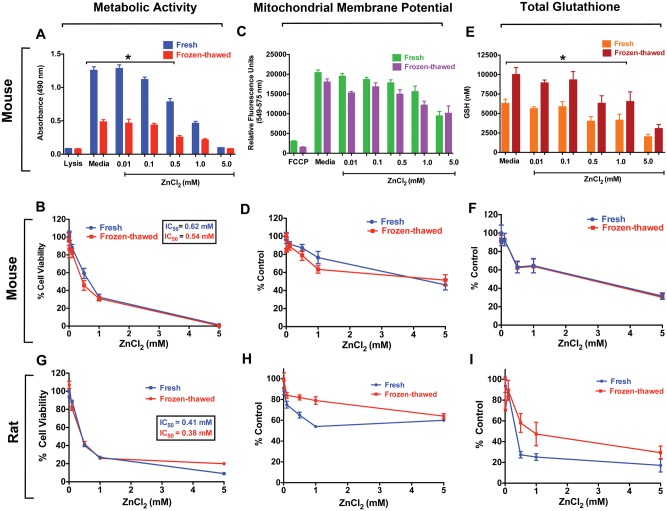FIG. 3.
Cryopreservation of PCLS does not alter responses to ZnCl2. A, As measured by the MTS, there was a difference in the raw absorbance values between fresh and frozen-thawed PCLS in response to ZnCl2 (0.01–5 mM). B, Normalized data showed identical dose-response between fresh and frozen-thawed mouse PCLS. C, Mitochondrial membrane potential assessed by TMRE assay revealed no significant differences between fresh and frozen-thawed mouse PCLS. D, Normalized data showed similar dose-response between fresh and frozen-thawed mouse PCLS in mitochondrial function. E, Fresh PCLS had lower glutathione levels than frozen-thawed PCLS. F, Normalized data showed identical dose-response between fresh and frozen-thawed mouse PCLS in glutathione levels. G, Metabolic activity of rat fresh and frozen-thawed PCLS both revealed similar reductions with increasing ZnCl2 concentrations. H, The mitochondrial membrane potential was reduced in both fresh and frozen-thawed rat PCLS. I, Significant reduction in total glutathione levels in both fresh and frozen-thawed rat PCLS was observed in response to ZnCl2. Positive controls for the MTS assay were 0.01% Triton X-100 and carbonyl cyanide-4-(trifluoromethoxy) phenyl hydrazone (FCCP) (1 µM), a potent ATP synthesis disruptor, for the TMRE assay. Data are mean ± SE. Each exposure group consisted of a total of 18 PCLS (3 PCLS per rat, 6 rats) and 18 PCLS (3 slices per mouse, 6 mice). (*P < .05, ANOVA followed by Bonferroni’s post hoc test).

